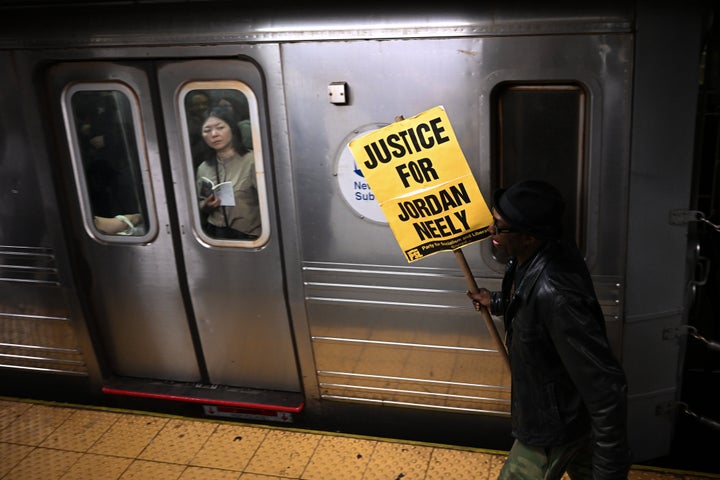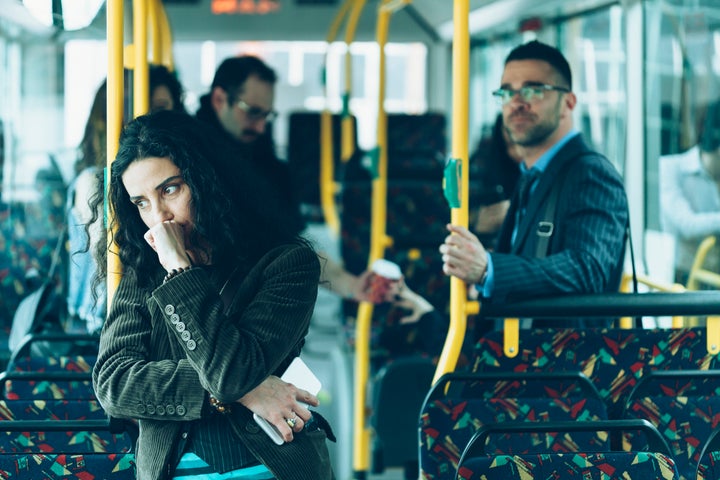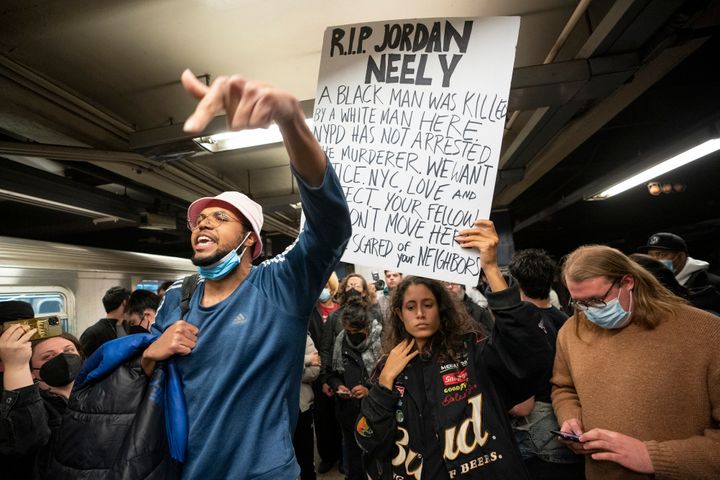This month, demonstrators have taken to the streets and subway stations in New York City to protest the killing of Jordan Neely, a 30-year-old man who was choked to death by another passenger on a train in Manhattan on May 1.
Many have suggested that Neely, who was experiencing homelessness, could have been in a mental health crisis at the time: He was reportedly shouting to others on the train that he was hungry, that he didn’t care about going to jail, that he was ready to die.
At some point, Daniel Penny, a 24-year-old Marine veteran, placed Neely in a minuteslong chokehold, which was caught on film. (The video also shows that others were involved in the incident to varying degrees, with at least one possibly helping to hold Neely down.)
The city medical examiner ruled Neely’s killing a homicide, noting that he died due to a “compression of neck (chokehold).” Penny was questioned after the altercation but then released. A grand jury is expected to decide this week whether to bring criminal charges against him.
Outrage over Neely’s killing came almost immediately. Some alleged that the deadly encounter was tied to a discomfort that white people feel around Black people, especially those who are mentally ill or poor.
Lauren Taylor, the founder and director of Defend Yourself, a self-defense organization based in Washington, said she agrees with this view.
“Jordan Neely lived in a society that devalues each of those identities and dehumanizes people who [belong to those groups],” she said, suggesting that his killing amounted to a crime. “It’s extremely unlikely he would have been murdered if he had been white.”
“White people in our society also view Black men as larger and more threatening ― as do Black people, but less so,” she added. “It’s almost certain that this aspect of structural racism played a piece in Penny’s decision to attack him.”
The other much-discussed facet of this story is the apparent lack of action from many riders on the train. Some are wondering if de-escalation tactics could have made a difference in a situation like this, where someone is clearly in distress.
In a widely shared story in The Nation, political commentator Elie Mystal offered a rationale for why bystanders may have frozen:
In a country where it feels like any conflict can escalate from heated words to mass murder in an instant, it’s not surprising that most people will just look the other way. I’d like to think that, had I been on the train, I would have said something. “Please stop, you’re killing that man.” But would I have physically intervened? Would I have tangled with soldier boy to try to break the choke hold? I don’t know. I suspect not, to my shame.
It’s important to note that some people did act — like the freelance journalist who was recording (an action that Taylor said can influence aggressors to stop what they’re doing) and a person who seemingly warned Penny to be careful.
“You don’t have to catch a murder charge,” the person is heard saying in the footage. “You got a hell of a chokehold, man.”
New York Daily News via Getty Images
In some cases, just making a verbal comment like that can help defuse the situation, said Steven Dinkin, the president of the National Conflict Resolution Center, a San Diego-based group that offers mediation and conflict resolution trainings.
“While our organization doesn’t recommend physical intervention, a situation can sometimes be de-escalated just by acknowledging the person and asking simple questions, then listening to their response,” he said.
Dinkin told HuffPost that a calm verbal acknowledgement can be “helpful and may provide an opening to appeal to a person’s values and increase their willingness to consider options for resolving the situation.”
In the Neely case, some just watched the scene unfold ― an apparent example of the bystander effect, which occurs when the presence of others discourages an individual from intervening in an emergency situation.
Psychologists Bibb Latané and John Darley, who first popularized the concept, attributed this phenomenon to two factors: diffusion of responsibility (that is, the thinking that someone else will step in) and social influence (with observers seeing the inaction of others as evidence that nothing needs to be done).
In contrast to a bystander, an “upstander” is someone who intervenes or interrupts to help stop a dangerous or unlawful incident.
“It only takes one person to move from a freeze state and provide support based on consent, solidarity and recognizing the inherent dignity of the person who is experiencing a crisis,” said Kalaya’an Mendoza, the director of mutual protection at Nonviolent Peaceforce, an international NGO focused on preventing and reducing conflict.

Alexi Rosenfeld via Getty Images
What could have been done in the Neely case, and what should you do in a context where someone is in a mental health crisis or getting violent? Speaking to HuffPost, experts in de-escalation shared their advice for anyone who wants a variety of tools that could help.
Take a deep breath and ground yourself.
In potentially stressful situations, you’re more likely to be effective when calm and centered instead of fearful and angry. This will help if you’re trying to reason and establish an on-the-fly relationship with someone who’s having a mental health crisis, Mendoza said.
“What this means is to create a moment of pause,” he said. “Are you in an emotionally regulated ― not necessarily comfortable, but regulated ― space where you are cool, calm, collected and connected? Before even providing support, build in this moment of pause, then assess.”
Put your safety first.
How do you assess safety ― for yourself, others and an individual in crisis — during a public incident?
Taylor said to think about these questions: How escalated is the potentially dangerous person? Do they seem to have a weapon? Who else is around? Might they also be a threat? Could they be of help to you? Where are the exits? Where is the safest place to be?
Ask yourself, ‘Who is the real threat to whom here?’
Research suggests that people with mental illness are more likely to be victims of a crime than to commit one. Studies also indicate that homeless people are more likely than housed people to be victims of violent crime. Indeed, the past few years have seen an apparent spike in violence against such people, with the visibility of homelessness increasing amid the COVID-19 pandemic.
Antoinette Chen See, a facilitator at Fireweed Collective, which offers mental health education online, said that if you see someone in crisis, you should ask yourself, “Who is the real threat to whom here?”
“Mentally ill folks experience higher rates of violence than the general population,” she said. “So we should shift the conversation from ‘how to de-escalate a person in an altered state’ to ‘how do I work on my internalized fear of mental illness so I do no harm to mentally ill folks?’”
When you witness an alarming scene, it might be helpful to behave as if those involved are loved ones and people you care about personally, Chen See said.
“Act as if your intervention, no matter how small, could be the difference between them going home or not, because in many cases it is,” she said.
Take action based on your assessment.
Can you and others leave the area? That’s often the easiest and safest way to de-escalate a situation with a person in public, Taylor said.
“If that’s not an option, stand diagonally to them, with your hands low and visible,” she said. “Put on your listening face and show that you are calm, even if you’re faking it. With a quiet voice, ask questions, listen to them and empathize. Work to build a connection.”
Often, phrases like these can bring the temperature down, according to Taylor:
- “I’m sorry that happened.”
- “It sounds like …”
- “That’s terrible! What can I do to help?”
- “Yeah, I hear that …”
- “I see that you’re upset.”
If you reach out to a person involved, keep your distance.
If you approach a person during an incident, Dinkin said to maintain enough physical distance to allow them to feel safe.
“Make eye contact, but break it if they become more agitated,” he said. “Speak slowly and calmly to the person and ask simple questions, like ‘how can I help you?’”
Try to get across that you’re on their side, said Chen See.
“Communicate and explain your intentions. and that you won’t do or make them do anything they don’t want to,” she said.
If they’re in a crisis, try gathering from them what would make them feel safer and what would make them comfortable, Chen See added.
You don’t have to do this alone, either. You can enlist other bystanders to provide support, such as by contacting mental health services.

Vladimir Vladimirov via Getty Images
Consider calling a crisis hotline rather than 911.
Though dialing 911 may seem like the first thing to do when someone is threatening to harm themselves or otherwise in crisis, doing so can sometimes have fatal consequences.
“The police officer might be perceived as threatening and/or symbolic of an arrest rather than help,” Jessica Isom, a psychiatrist based in Boston, told HuffPost in 2020. “Not all police officers are trained and competent to provide critical intervention services.”
Consider calling a crisis hotline first. The National Suicide Prevention Lifeline (whose phone number in the U.S. is 988) can direct you to a local crisis center. You can also call state or county mental health services located nearby, which may offer crisis hotlines.
Figure out a mutually acceptable solution.
See if you can defuse the situation by coming to a resolution with the person involved, Taylor said.
“Your resolution could be a mutually acceptable solution (‘How about we go down the block and I buy you some food? Would you like me to call your sister/caseworker/etc. for you?’), asking them to leave, or getting another kind of help, like a calling a mental health first-responder team,” she said.
What if I see a physical altercation involving a person in crisis?
Beyond just de-escalation, bystander intervention strategies might quell situations like the one with Neely and Penny. In its training courses, the group Right To Be teaches that there are five different methods ― “the 5Ds” ― for intervening when witnessing harassment or physical violence in public.
You can distract (by asking for directions, for instance); delegate (by asking for help); document (by recording video or audio); delay (by checking in on the harassed person after the incident is over); or direct (by speaking out directly to the attacker, as at least one person apparently did with Neely and Penny).
Which intervention a person may choose is influenced by their skills and personality, Taylor said: You may be better at getting people to calm down, while another person is better at assertively getting someone to stop what they’re doing when that’s called for.
“It also depends on their identities,” she said. “It probably would have been more effective for a large white man to try to get Penny to stop than a Black man or even a Black woman.”
Life experiences play a part, too.
“There was no way to know at the time that Penny was a Marine. But if something happened in a situation where something like that was known, another service member would have been a good person to step up,” Taylor said.
To prepare, take a de-escalation class.
Ideally, you’ve thought about what you’d do in a situation before you’re thrown into a high-stakes, real-life event. That’s why Mendoza encourages everyone to attend situational awareness and de-escalation trainings. (Not sure where to sign up? Princeton University’s Bridging Divides Initiative has created a directory of local and national resources.)
“Trainings are a good way to build your muscle memory around ways to provide mutual protection to those most marginalized in our society,” Mendoza added.
“The only way to build true safety is through building solidarity and community,” he said. “Our society can only be safe when those most directly affected by structural violence are safe.”
Need help with substance use disorder or mental health issues? In the U.S., call 800-662-HELP (4357) for the SAMHSA National Helpline.
Dial 988 or call 1-800-273-8255 for the National Suicide Prevention Lifeline. You can also get support via text by visiting suicidepreventionlifeline.org/chat. Additionally, you can find local mental health and crisis resources at dontcallthepolice.com. Outside of the U.S., please visit the International Association for Suicide Prevention.


